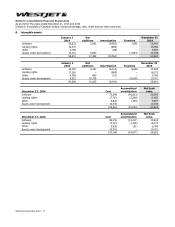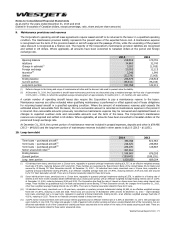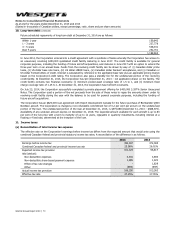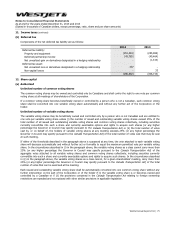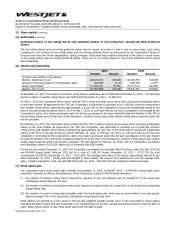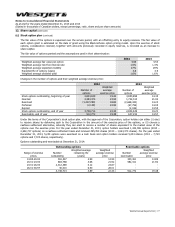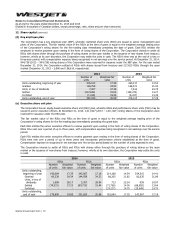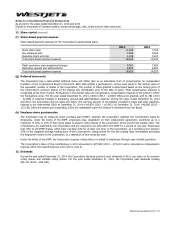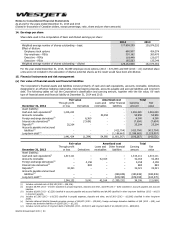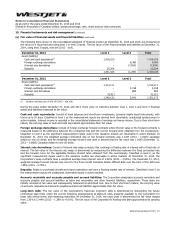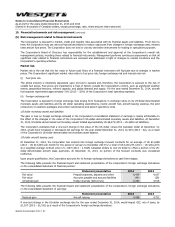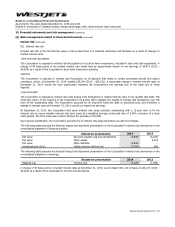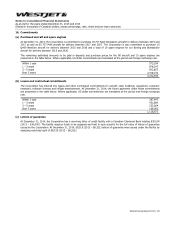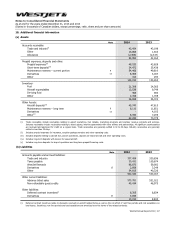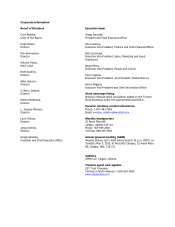Westjet 2014 Annual Report Download - page 84
Download and view the complete annual report
Please find page 84 of the 2014 Westjet annual report below. You can navigate through the pages in the report by either clicking on the pages listed below, or by using the keyword search tool below to find specific information within the annual report.
Notes to Consolidated Financial Statements
As at and for the years ended December 31, 2014 and 2013
(Stated in thousands of Canadian dollars, except percentage, ratio, share and per share amounts)
WestJet Annual Report 2014 │ 82
15. Financial instruments and risk management (continued)
(b) Risk management related to financial instruments
The Corporation is exposed to market, credit and liquidity risks associated with its financial assets and liabilities. From time to
time, the Corporation may use various financial derivatives to reduce exposures from changes in foreign exchange rates, interest
rates and jet fuel prices. The Corporation does not hold or use any derivative instruments for trading or speculative purposes.
The Corporation’s Board of Directors has responsibility for the establishment and approval of the Corporation’s overall risk
management policies, including those related to financial instruments. Management performs continuous assessments so that all
significant risks related to financial instruments are reviewed and addressed in light of changes to market conditions and the
Corporation’s operating activities.
Market risk
Market risk is the risk that the fair value or future cash flows of a financial instrument will fluctuate due to changes in market
prices. The Corporation’s significant market risks relate to fuel price risk, foreign exchange risk and interest rate risk.
(i) Fuel price risk
The airline industry is inherently dependent upon jet fuel to operate and, therefore, the Corporation is exposed to the risk of
volatile fuel prices. Fuel prices are impacted by a host of factors outside the Corporation’s control, such as significant weather
events, geopolitical tensions, refinery capacity, and global demand and supply. For the year ended December 31, 2014, aircraft
fuel expense represented approximately 31% (2013 – 32%) of the Corporation’s total operating expenses.
(ii) Foreign exchange risk
The Corporation is exposed to foreign exchange risks arising from fluctuations in exchange rates on its US-dollar-denominated
monetary assets and liabilities and its US dollar operating expenditures, mainly aircraft fuel, aircraft leasing expense, the land
component of vacations packages and certain maintenance and airport operations costs.
US dollar monetary assets and liabilities
The gain or loss on foreign exchange included in the Corporation’s consolidated statement of earnings is mainly attributable to
the effect of the changes in the value of the Corporation’s US-dollar-denominated monetary assets and liabilities. At December
31, 2014, US-dollar-denominated net monetary assets totaled approximately US $6,073 (2013 – US $256 net liabilities).
The Corporation estimates that a one-cent change in the value of the US dollar versus the Canadian dollar at December 31,
2014, would have increased or decreased net earnings for the year ended December 31, 2014, by $44 (2013 – $2), as a result
of the Corporation’s US-dollar-denominated net monetary asset balance.
US dollar aircraft leasing costs
At December 31, 2014, the Corporation has entered into foreign exchange forward contracts for an average of US $11,689
(2013 – US $13,439) per month for the period of January to December 2014 for a total of US $140,273 (2013 – US $161,273)
at a weighted average contract price of 1.1187 (2013 – 1.0425) Canadian dollars to one US dollar to offset a portion of its US-
dollar-denominated aircraft lease payments. At December 31, 2014, no portion of the forward contracts was considered
ineffective.
Upon proper qualification, the Corporation accounts for its foreign exchange derivatives as cash flow hedges.
The following table presents the financial impact and statement presentation of the Corporation’s foreign exchange derivatives
on the consolidated statement of financial position:
Statement presentation
2014
2013
Fair value Prepaid expenses, deposits and other 6,409 4,187
Fair value Accounts payable and accrued liabilities (49) (29)
Unrealized gain Hedge reserves (before tax) 6,360 4,158
The following table presents the financial impact and statement presentation of the Corporation’s foreign exchange derivatives
on the consolidated statement of earnings:
Statement presentation 2014 2013
Realized gain Aircraft leasing 9,498 4,752
A one-cent change in the US-dollar exchange rate for the year ended December 31, 2014, would impact OCI, net of taxes, by
$1,037 (2013 – $1,192) as a result of the Corporation’s foreign exchange derivatives.


